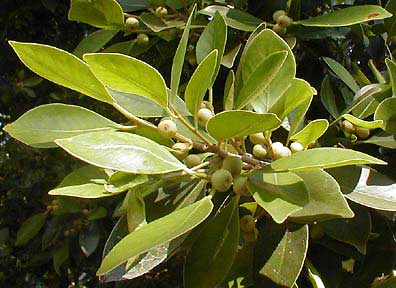STRANGLER FIGS

Especially around old haciendas and in towns in northern Yucatan, and in forests farther south, strangler fig trees are common and conspicuous. They are easy to identify because the lower part of their trunks more or less look like what you see at the right: The bark is gray and smooth, and the "roots" seem to melt into one another and flow around rocks.
The reason for the strange trunk is that strangler figs begin their lives on the branches of other trees. Strangler fig fruits are gummy and full of tiny seeds, which birds eat. When birds clean their bills on a tree branch, strangler fig seeds get planted and eventually germinate there. The resulting sprout is a tree-living epiphyte. Since stranger figs do not steal nutrients from their host trees but rather photosynthesize their own food with their own green leaves they are not parasites.
The young strangler fig sends several special rootlike stems down to the soil, reach water and nutrients. Gradually its stems wrap around the host tree's trunk, grow and fuse together until they more or less form a cylinder surrounding the trunk. Meanwhile, up in the tree, the young stranger is growing in a bushy fashion, eventually looking like a small tree growing atop the host tree.
With time, the strangler fig overtops its host and its cylindrical network of stems begins looking like a regular tree's trunk encasing the host tree's trunk. The host tree suffers because it loses sunlight, nutrients and water to the strangler. Finally the host tree dies and the strangler is left looking as if it were a normal tree with a typical trunk.
 Strangler figs are closely related to the trees producing the figs we buy in supermarkets. However, most strangler fig fruits are so small -- about the size of peas or marbles -- and bitter that humans don't bother to eat them. However, many kinds of wildlife relish them, especially birds such as parrots. The green, spherical items in the picture are strangler fig fruits.
Strangler figs are closely related to the trees producing the figs we buy in supermarkets. However, most strangler fig fruits are so small -- about the size of peas or marbles -- and bitter that humans don't bother to eat them. However, many kinds of wildlife relish them, especially birds such as parrots. The green, spherical items in the picture are strangler fig fruits.
There are many species of strangler fig, but they all belong to the genus Ficus, same as the tree producing edible figs. Unlike the fig tree producing edible figs, which has large leaves shaped like mittens, strangler figs have simple leaves with smooth margins, as shown in the picture above.